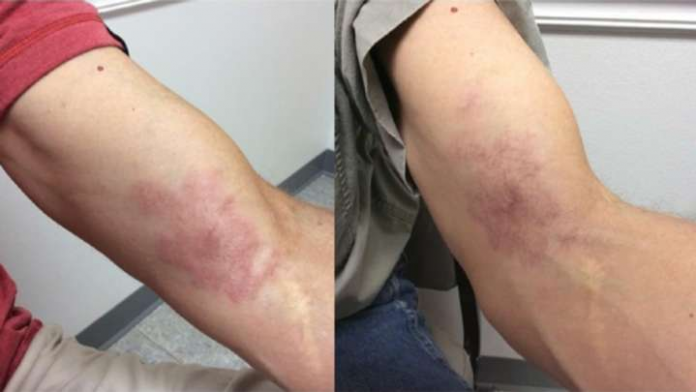A 58-year-old man reported into the clinic in Florida with an odd mark on his arm. While complaining about the mark, the patient gave a history that the lesion on his arm had been present for 5 months and was increasing in size; moreover, caused him occasional sharp pain. The patient also experiences decreased sensation in the affected area. Previously, the patient had been admitted into an urgent care center and was tested for Lyme disease. However, his results for Lyme disease came out as negative, crossing that out of the differential diagnosis.
He was sent home after being prescribed antihistamines for the irritation on his skin. However, he returned to the clinic a few months later when his inflammation got worse. The cause of the lesion on the man’s arm was still unknown and the doctors were unsure of what was causing the lesion. The possibilities were somewhat widened after the patient told the doctors that he was a self-proclaimed outdoors person; the doctors then ruled out toxoplasmosis and deep fungal infection as possible causes of the lesion.
The doctor’s explored further back into the past of the man, in an attempt to widen the field of possibilities. They discovered that 30 years prior to his job, this 58-year-old man had been an armadillo hunter. For scientific research purposes, he would hunt for armadillos, trap and sell them to researchers. It opened up a possibility that the patient could, in fact, have leprosy.
Leprosy is not very common in the United States. Also known as Hansen’s disease, there are around 200 cases reported in the US each year. Most cases of Leprosy are either transmitted because of breathing in the airborne bacteria, because of direct contact with an infected person or being infected through damaged skin or a wound. According to US authors, 60 to 75 percent of the cases, which is majority of the cases occur in either those who have been in close contact with the disease or in immigrants. The disease is especially common in those from Marshall Island and Federal States of Micronesia. In addition to this, over the last 20 years, the largest number of new cases of leprosy were reported in the Gulf Coast states. The transmission of disease was most likely from armadillos. Likewise, M. leprae can be spread in the southern region of USA because of armadillos shedding bacilli through their body excretions into the environment. According to a case report (Logan & Holloway, 2019), the bacteria can survive in the environment for up to 8 months. Leprosy has an incubation period of 8 to 12 years and due to the long incubation period, leprosy is difficult to diagnose. Moreover, there are no diagnostic tests available to identify the infection before the appearance of clinical symptoms.
In conclusion, after several consultations and tests with experts, the patient was diagnosed with leprosy. The treatment plan included a course of several antibiotics, with expectations of full recovery for the patient. The patient was called in for a follow up after 5 months; the lesion on the man’s arm had shrunk considerably and sensation as returning.
Reference
Logas, C. M., & Holloway, K. B. (2019). Cutaneous leprosy in Central Florida man with significant armadillo exposure. BMJ Case Reports CP, 12(6), e229287.




